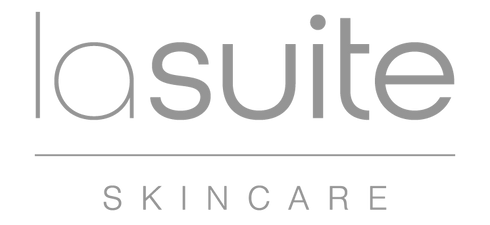Hyperpigmentation: The Dark Side of the Sun

Bikinis, bonfires, sunsets: ahhh, summer is a seductive time of year. Many of us are even tempted to tan those dark spots into obscurity—but that quick fix has a cost come fall. Hyperpigmentation is one of our clients’ most common complaints at La Suite, especially after several months of enjoying the outdoors.
WHAT IS HYPERPIGMENTATION?
Hyperpigmentation is a common, usually harmless condition that can affect skin of any tone or race. It’s when patches of skin become darker in color than the surrounding skin. Melanin is the brown pigment that gives our skin color and protects against the harmful effects of UV light. But excess melanin production is the body’s natural defense against sun overexposure. That darkening or tan is essentially a “scar”! No matter the trigger (sun damage, hormones, inflammation, injury or prescription drugs), all hyperpigmentation is caused by an increase in melanin. Therefore, treatment and prevention involves inhibiting its overproduction.
If you spent your youth sunning without SPF-ing, you’re not alone. Hyperpigmentation can be the result of sun damage in childhood, but there are other causes as well. There is growing evidence that air pollution plays a significant role in hyperpigmentation.1 And all three types of hyperpigmentation are worsened by further sun exposure. Read on to learn about sunspots, melasma, and post-inflammatory hyperpigmentation.

Sunspots (age spots, liver spots):
We’ve all got ‘em. Sunspots are the result of sun exposure over time and are referred to by doctors as solar lentigines. These small, darkened patches are generally found on skin most exposed to the sun, like the face, hands, and décolleté.

Melasma:
Melasma (or chloasma) refers to larger areas of darkened skin that can appear as a result of overproduction of melanin due to hormonal changes and radiation such as light, heat or UV exposure. Pregnancy can trigger overproduction of melanin, resulting in a "mask of pregnancy" on the face or stomach. Certain medications like birth control pills can also incite melanin, causing hyperpigmentation.
Melasma is usually symmetrical and is mirrored on both sides of the face, often on both cheeks or above the eyebrows. Sometimes melasma goes away after pregnancy or going off the Pill—but often not. Irritating skincare products, treatments, or anything that stirs up skin inflammation can also cause melasma flareups—so check your medicine cabinet for culprits!

Post-inflammatory hyperpigmentation (PIH):
If you’ve ever popped a pimple, sadly you’ve probably encountered PIH. It’s one of the reasons why extractions are best left to professionals! Acne, as well as insect bites, cuts or abrasions, burns, or surgical incisions can all result in discoloration of the skin.
HOW CAN I TREAT MY HYPERPIGMENTATION?
Successful treatment of hyperpigmentation involves consistency, patience and a multi-pronged approach that includes every weapon in the skincare arsenal to keep overproduction of melanin at bay. At La Suite, we recommend a combination of professional peels and at-home care heavy on melanin inhibiting ingredients.
At the Clinic
Chemical peels are one of the most effective ways to remedy sun “overexposure.” That’s why veteran La Suite clients have standing post-summer facial appointments! Chemical Peels use acid solutions of varying strengths that promote cell turnover to exfoliate, brighten and improve skin clarity, tone and texture. Our goal at La Suite is to achieve maximum, progressive results with minimal downtime. Peels not only visibly minimize the effects of environmental damage caused by UV radiation and pollution, they also stimulate your skin’s natural hyaluronic acid and collagen production for stronger, better functioning, healthy looking skin.
Which chemical peel is best for you? Call us at 203-861-7338 to learn more about your customized treatment.
LED (Light Emitting Diodes) are wavelengths of light used to stimulate overall cell functioning and promote an even skin tone, among other benefits. LED can be added to your FaceTime treatment.
At Home
La Suite recommends topical treatments rich with ingredients to help brighten and even the skin tone. These “non-negotiables” both prevent and minimize sun damage—because even on the wintriest of days, UV rays are out there, waiting to strike!
- Vitamin C / Ascorbic Acid (supported by Vitamin E) - Rhea recommends our Vitamin C Brightening Antioxidant Serum or Vitamin C + E + Ferulic Acid Soothing Antioxidant Serum for those with sensitive skin.
- Vitamin A, like La Suite’s best-selling Retinol Serum.
- Mineral sunscreen that includes zinc oxide, minimum SPF 30. We can’t keep this Sheer one in stock.
Many of La Suite’s signature products include other powerful ingredients that fight hyperpigmentation:
- AHAs like Glycolic, Lactic, and Phytic acids
- Hydroquinone
- Botanical brighteners like Kojic Acid, Arbutin (Bearberry) and Emblica
- Licorice Root
- Azelaic acid
- Tranexamic acid
- Niacinamide
- Resorcinol
- Green Tea Polyphenols
Call us or schedule your Virtual Consultation to determine which are right for you.
HOW CAN I PROTECT AGAINST HYPERPIGMENTATION?
“Protecting your skin is the best beauty investment,” says Rhea. And it doesn’t have to cost a fortune. Let’s review the basics:
- Avoid sun exposure. Use a mineral sunscreen with a minimum of SPF 30, 365 days a year. Reapply after swimming or sweating, and at least every two hours.
- During the day, apply antioxidants, especially Vitamin C, in conjunction with sunscreen. Our genius mineral sunscreen formulas contain Vitamins C, E and other powerful antioxidants for even better protection.
- Don’t pick at your skin! Leave any treatment of spots, scabs, or acne to the experts.
- Wear sunglasses, hats, and clothing that block sunlight.
- Avoid the sun when it is at its strongest, typically 10 a.m. to 4 p.m.
- Certain medications may cause hyperpigmentation; ask your doctor and take the precautions above.
While a leopard can’t change its spots, La Suite has got some game-changing treatments for yours. Call us at 203 861 7336 or email us at hello@lasuiteskincare.com and let us brighten and restore evenness to your hyperpigmented skin.
1. Source https://jddonline.com/articles/dermatology/S1545961615P0337X
